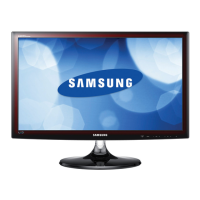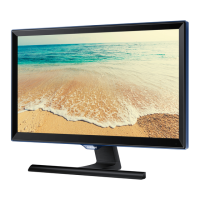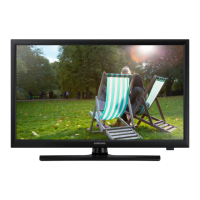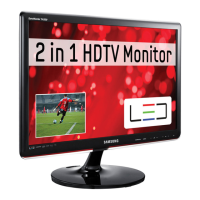Do you have a question about the Samsung T20A350 and is the answer not in the manual?
Information on digital TV compatibility, potential issues, and warnings about displaying static images.
Guidelines for ensuring proper ventilation and safe installation space around the TV.
General safety icons and warnings covering injury, property damage, and electrical hazards.
Safe practices for using power cords, plugs, and outlets to prevent electric shock and fire.
Warnings for installation, including ventilation, placement, and wall mounting.
Precautions regarding sunlight, heat, ventilation, children's access, and product stability.
Safe methods for cleaning the TV and warnings against self-disassembly or unauthorized repairs.
Safety measures for unusual product behavior, dropping, lightning, and safe handling.
Precautions for airflow, flammable materials, inserted objects, and gas leaks.
Warnings about liquids, object placement, eye strain, and proper posture.
Safety guidelines for accessories, battery handling, and proper disposal.
List of all items included in the TV package.
Recommendations for cable thickness for optimal connection.
Step-by-step instructions for assembling and attaching the TV stand.
Important notes regarding height adjustment and handling during stand installation.
Explanation of the buttons located on the TV's control panel.
Information on power consumption when the TV is in standby mode.
Detailed guide to the remote control's buttons and their respective functions.
Instructions for correctly inserting batteries into the remote control.
Guide on how to connect an antenna for TV reception.
Steps for initial TV setup, including language, country, and channel configuration.
Procedure to reset the initial setup settings using the PIN.
Connecting digital devices like DVD players and set-top boxes via HDMI.
Advice on using certified HDMI cables for optimal performance.
Instructions for physically attaching the CI card adapter to the TV.
How to insert and use a CI or CI+ card for paid channels.
Important considerations and potential issues when using a CI card.
Connecting external audio systems and headphones using optical or headphone jacks.
Details on 5.1 CH audio output and limitations when connecting via HDMI.
Connecting a PC using HDMI, DVI, or D-sub cables.
Table of supported PC resolutions and refresh rates for different screen sizes.
How to change input sources and rename connected devices.
Accessing information about connected external devices.
Step-by-step guide to navigating the On-Screen Display (OSD) menus.
Viewing current and upcoming program information.
How to view and browse available channels.
Accessing features like Watch TV, My Downloads, and Source.
Utilizing the EPG to view schedules and set program reminders.
Viewing, modifying, or cancelling program reservations.
Setting timers to automatically change channels at specific times.
How to view all scanned channels and use list navigation features.
Setting program timers directly from the channel list.
Adding, editing, and managing favourite channels.
Locking, unlocking, renaming, and deleting channels.
Procedure for rescanning and updating available channels.
Selecting the country and performing automatic channel tuning.
Explanation of Full, Network, and Quick scan modes for auto tuning.
Steps for manually scanning for digital and analogue channels.
Choosing between P, C, and S modes for channel selection.
Manually adjusting analogue channel reception for clarity.
Using USB to import or export channel lists.
Selecting and customizing preset picture modes like Standard, Dynamic, Movie.
Optimizing picture quality based on viewing position.
Adjusting settings like backlight, contrast, brightness, and sharpness.
Managing picture size (16:9, 4:3, Zoom) and screen fit options.
Adjusting PC screen settings like coarse/fine tuning, position, and image reset.
Steps for setting up the TV to display a computer's screen.
Recommendations for maintaining correct posture while viewing the TV.
Adjusting colour tone, noise filters, and HDMI black level.
Fine-tuning black tone, contrast, gamma, white balance, and edge enhancement.
Choosing sound modes like Standard, Music, Movie, and Clear Voice.
Using SRS, TruDialog, and the equalizer for audio enhancement.
Setting audio language and format for digital broadcasts.
Adjusting the volume level for digital TV audio signals.
Configuring digital audio output formats and line/RF levels.
Choosing between TV and external speakers and setting auto volume.
Setting the TV's clock automatically or manually.
Manually setting the clock, time zone, and daylight saving time.
Setting the TV to automatically turn off after a preset time.
Configuring the TV to turn on automatically at scheduled times.
Setting the TV to automatically turn off at scheduled times.
Locking channels and programs based on ratings to restrict access.
Changing PIN, and procedures for viewing restricted channels.
Adjusting settings for energy saving, including picture off and no-signal power off.
Setting the menu language and preferred broadcast languages.
Configuring subtitle display and audio description features.
Optimizing power consumption and enhancing gaming experience.
Enabling and configuring Anynet+ for device control.
Information regarding DivX Video-on-Demand registration and playback.
Using the CI menu and installing the CAM module.
Proper use of CI+ cards and troubleshooting scrambled signals.
How to enable and configure Picture-in-Picture mode.
Checking signal strength and basic troubleshooting steps.
Methods for upgrading TV software via broadcast signal or USB.
Step-by-step guide for upgrading software using a USB drive.
Playing photos, music, and video files from a USB mass storage device.
Procedure for connecting USB storage devices to the TV.
Important compatibility information and precautions for USB devices.
Navigating the My Downloads interface and viewing content lists.
How to play video files, including supported subtitle formats.
List of supported video file extensions and codecs.
List of supported audio codecs and format limitations.
Instructions for selecting and playing music files.
How to view photos individually or as a slide show.
Available options for controlling media playback, including search, shuffle, and zoom.
Explanation of the Anynet+ feature for controlling Samsung devices.
Diagram and steps for connecting home theatre systems via HDMI.
Important considerations and limitations for Anynet+ connections.
Overview of menu options for managing Anynet+ devices.
Steps to enable and configure the Anynet+ function.
How to select and switch between Anynet+ enabled devices.
Instructions for recording TV programs using a Samsung recorder.
Using an external receiver for audio output instead of TV speakers.
Common problems with Anynet+ and their possible solutions.
Steps for installing the display driver from the CD or website.
How to access, navigate, and use the Teletext service.
Explanation of remote control buttons used for Teletext.
Description of the layout and information displayed on a Teletext page.
Steps to prepare the TV and workspace before attaching a stand or mount.
Step-by-step guide for attaching the wall mount or desktop stand.
Important notes on screw compatibility and VESA specifications for wall mounts.
Using the cable holder to organize and hide cables.
Securing the TV in public places using a Kensington lock.
Resolving issues like 'Mode Not Supported' and no audio from PC.
Troubleshooting fuzzy images, distortion, colour, and brightness issues.
Addressing dotted lines, black/white images, and channel freezing.
Diagnosing and resolving issues with no sound or low volume.
Troubleshooting unusual noises from the TV speakers.
Resolving problems with the TV not turning on, turning off automatically, or showing no picture.
Troubleshooting issues with receiving all channels or poor signal.
Addressing full-screen display, remote control functionality, and mode support.
Resolving difficulties with stand assembly, plastic smell, or tilted TV.
Resolving issues with greyed-out channel menus or lost settings.
Troubleshooting intermittent audio/video loss, PIP availability, and signal messages.
Addressing unexpected TV power-on and potential furniture interaction.
Guidelines for safely cleaning the TV screen and product body.
Information on licences for technologies like Dolby, DTS, and DivX.
Details regarding the use of open-source software.
Information on the proper disposal of electrical and electronic equipment.
Guidelines for the correct disposal and recycling of batteries.
Details on operating temperature, humidity, and tilt range.
Information on TV system, colour, sound, and HDMI input specifications.
Comparison of screen size, resolution, dimensions, and weight across different models.
Contact details and website information for Samsung customer support worldwide.











